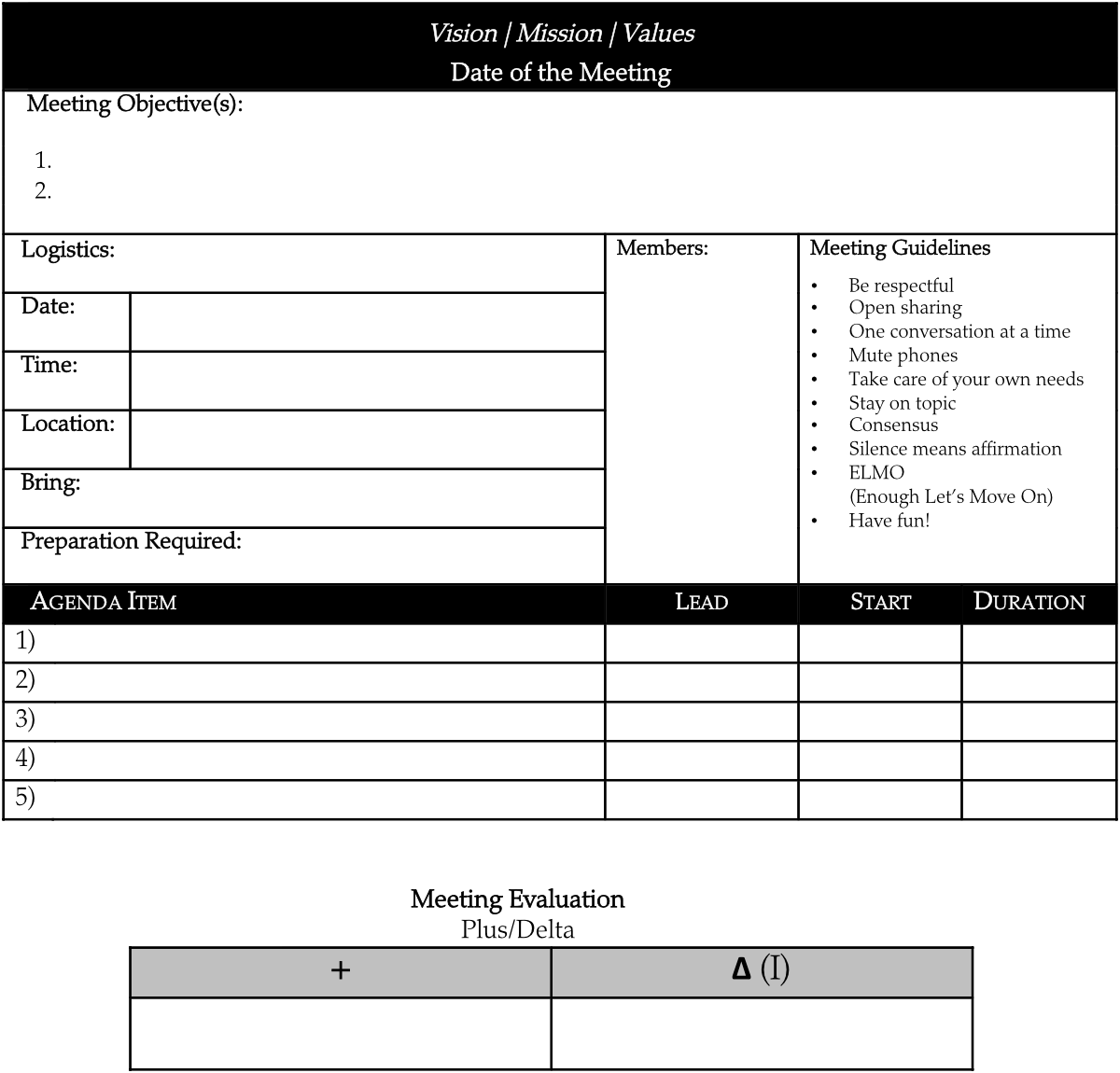Another meeting?
How many of the following statements describe your feelings about meetings?
I’m tired of:
- Having meetings, just to have a meeting or to say, “we met”
- Meeting without a purpose or objective
- Not knowing why I am in the meeting
- Not staying on track or starting/ending on time
- Continuing to discuss the same topic and not reaching a decision
- Making decisions without enough information
- Not hearing from everyone—members withholding their thoughts until after the meeting
You could add a few more, but I’ve said all these—often. Everyone has suffered through meetings that hijacked your day and zapped the life out of you.
Trying to squeeze in a phone call with my daughter has become a quest. Even when I call after work hours, I will hear, “Sorry mom I have one more meeting in five minutes.”
How well I remember rushing from meeting to meeting all day. I had little or no time to clear my brain and get focused for the next one.
Our work requires social interaction and communication with each other. The problem lies not in the meeting, but our planning, conducting, and review of our meetings.
Leaders brag about great two-way communication. Someone somewhere developed elaborate plans to share key messages. Does anyone read that stuff? Two-way communication involves closing a feedback loop, which looks something like this:
- I tell you something.
- You listen.
- You respond to my “something.”
- I hear your response and acknowledge that I understand.
A well-planned effectively conducted meeting has the potential for valuable two-way communication. Add minutes and reviews of meetings and you further close the communication loop. Many, if not all, of the complaints about meetings, result from poor planning.
“A good rule in organizational analysis is that no meeting of the minds is really reached until we talk of specific actions or decisions.”
— Joseph M. Juran
What you need is a process!
My position required gathering groups together for planning and implementation of strategy. No one wanted to come. I couldn’t blame them since their schedule looked like mine.
Always trying to find a better way, I came up with a process for meetings. How we orchestrate our time for collaboration makes a difference. Will we have a dreaded meeting or an opportunity? Can we create quality time for dialogue, problem-solving, and great solutions?
I also love flow charts. Simple, easy to read flow charts give a clear view of what will happen and the sequence.

Starting Point: Identify the need for a meeting
Many meetings resemble disaster zones. If you don’t have a clear purpose for the meeting, confusion and sidebars control the action. You can spend twenty minutes trying to swim through murky water searching for a rock to hold onto.
Step 1: Develop a clear agenda
Another major flaw in planning occurs when we do not develop a clear agenda. An agenda includes simple guidelines such as:
- The purpose or objective of the meeting.
- The anticipated outcome or work products
- Topics for discussion and potential actions the meeting could generate
- A place holder to identify the owner of the topic or who will hold responsibility for the next steps
- A time limit for each agenda item. If the topic requires more time, what other items get deferred?
A good agenda addresses the bullet points above. This approach prepares the team for what will occur during the meeting. You reduce ambiguity and avoid surprises.
Step 2: Invite people required for the meeting
Invite only those who need to attend the meeting. Too often, meeting organizers feel compelled to invite everyone.
Don’t forget about indivuals who might be affected by decisions. If appropriate, include them in the planning and decision-making. When you make changes without input from those doing the work, you risk fixing the wrong things.
Step 3: Establish meeting ground norms
Ground norms or meeting guidelines set the parameters on how you and your team will behave. What do we need to ensure a smooth and productive meeting time?
As an example, I have often used the following:
- Be respectiful
- Open sharing
- One conversation at a time
- Mute cell phones
- Stay on topic
- Begin and end on time
Above all else–begin and end on time! Value people’s time and effort. You may find yourself and one other person the only people in the room, start anyway. As people meander in, tell them to get with a colleague later for what they missed.
You will always have one more members running from another meeting to get to yours. I know what you’re thinking, “we need that one person in the room before we start.”
If a critical member of the team still does not show up. Cancel the meeting. You waste your time and everyone else’s if you try to proceed. Believe me, this strategy works.
Before long, people know they can trust you to begin and end on time. They expect an agenda, which they receive before the meeting. Everyone in the room knows what to expect and why you included them in the meeting.
Step 4: Move through the agenda
If the team lacks the information to move to a decision or action, table that item. Nothing hurts an organization more than trying to make decisions in a vacuum.
What do you do if you begin to run out of time? Remember you set a one- or two- hour time limit. Honor that commitment.
You have a couple of choices. Review the remaining items to determine what you can defer to another time. Some items may not need group discussion, or you already covered them.
Sometimes, you know that the team could wrap up the most critical item in another 10-15 minutes. Ask the team for permission to extend the meeting. Be careful with this one. Use it rarely if at all.
Step 5: Review actions to take
Keeping track of who has responsibility for any next steps creates accountability. Specific timelines ensure the completion of products or reports. Without an assigned order and due date, you leave success to chance.
Don’t leave the room without every follow-up action assigned to a person. Not a title. A person who will own the work.
Step 6: Evaluate meeting effectiveness
Teams, even ad hoc teams, can learn from reflecting on their behavior and outcomes. An evaluation can be as simple as using a Plus/Delta tool at the end of every meeting.
I rarely close a meeting or presentation without asking, “What did we do well (plus)? What can I/we improve or do differently as we work together (delta)? What action do I/we need to take to improve or prepare for the next meeting?”
I don’t care if you liked the cookies or temperature in the room. If this team meets again, what do we need to remember to do again? Because it worked, and we used our time well.
What can we improve? What have we learned? Did we try to cover too many items? What information did we need to make better decisions? How could we come better prepared for the next meeting?
Keep this short. Reflection time will raise awareness of the behaviors important to the team’s productivity. As the facilitator or team leader, you give the team a chance to proactively make improvements.
Step 7: Write meeting minutes
As a facilitator or team leader, you have one more responsibility. Summarize the meeting and reiterate the tasks and owners of follow-up actions.
This doesn’t mean you capture discussions word-for-word. If you need that, record the meeting. Usually, a quick overview documents the discussion, decisions, and next steps.
Endpoint: Send completed minutes
Everyone invited to the meeting receives the minutes. No one else. You may have a reason to send minutes to others, but ask yourself why and what you will gain by doing so.
In conclusion
Bad meetings, over time, erode confidence and harbor resentment. Effective meetings bolster trust and contribute to positive relationships.After using an agenda and a few of these tips, watch what happens. Teammates will trust that you will begin and end on time. They know why you invited them.
You have a written plan of what the team will do. And you hold them accountable for the action items for which they are responsible.
Club meetings or volunteer organizations also face the hazards of poorly planned meetings. This process works wherever and whenever you bring a group together to take action.
I have included a sample meeting agenda. You can adapt the format, but I believe in simplicity.
Think about this . . .
If honest conversations only occur in the parking lot or the lunchroom, everyone suffers. You leave the best thinking and the most effective decisions to chance.
Make your next meeting a good one.
Sample Meeting Agenda




Leave A Comment